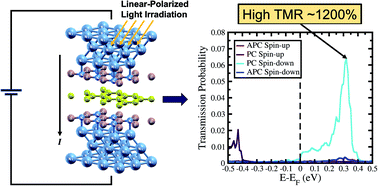High magnetoresistance of a hexagonal boron nitride–graphene heterostructure-based MTJ through excited-electron transmission†
Abstract
This work presents an ab initio study of a few-layer hexagonal boron nitride (hBN) and hBN–graphene heterostructure sandwiched between Ni(111) layers. The aim of this study is to understand the electron transmission process through the interface. Spin-polarized density functional theory calculations and transmission probability calculations were conducted on Ni(111)/nhBN/Ni(111) with n = 2, 3, 4, and 5 as well as on Ni(111)/hBN–Gr–hBN/Ni(111). Slabs with magnetic alignment in an anti-parallel configuration (APC) and parallel configuration (PC) were considered. The pd-hybridizations at both the upper and lower interfaces between the Ni slabs and hBN were found to stabilize the system. The Ni/nhBN/Ni magnetic tunnel junction (MTJ) was found to exhibit a high tunneling magnetoresistance (TMR) ratio at ∼0.28 eV for n = 2 and 0.34 eV for n > 2, which are slightly higher than the Fermi energy. The observed shifting of this high TMR ratio originates from the transmission of electrons through the surface states of the dz2-orbital of Ni atoms at interfaces which are hybridized with the pz-orbital of N atoms. In the case of n > 2, the proximity effect causes an evanescent wave, contributing to decreasing transmission probability but increasing the TMR ratio. However, the TMR ratio, as well as transmission probability, was found to be increased upon replacing the unhybridized hBN layer of the Ni/3hBN/Ni MTJ with graphene, thus yielding Ni/hBN–Gr–hBN/Ni. A TMR ratio as high as ∼1200% was observed at an energy of 0.34 eV, which is higher than the Fermi energy. Furthermore, a design is proposed for a device based on a new reading mechanism using the high TMR ratio observed just above the Fermi energy level.



 Please wait while we load your content...
Please wait while we load your content...